Influence of Scale Effect on Strength and Deformation Characteristics of Rockfill Materials
Abstract
:1. Introduction
2. Experimental Details
2.1. Experimental Equipment
2.2. Experimental Materials
3. Results and Discussion
3.1. Strength Characteristic Analysis
3.2. Analysis of Deformation Characteristics
3.3. Nonlinearity of Shear Strength
4. Conclusions
- (1)
- Under the same confining pressure, the smaller the maximum particle size is in the three groups of granular materials, the larger the corresponding peak deviator stress , the volume strain and stress ratio are at the phase transformation, which indicates that the soil particles have a higher overturning capacity, and the macroscopic performance is that HH2-20 material has a stronger dilatancy.
- (2)
- With the increase of confining pressure , the peak deviator stress and volume strain in the three groups of granular materials gradually increased, while the stress ratio at the phase transformation gradually decreased, and the stress ratio at the phase transformation showed a good linear relationship with the confining pressure .
- (3)
- In the linear shear strength index, with the increase of the maximum particle size , the cohesion of rockfill materials c gradually increases, while the internal friction angle of rockfill materials shows a downward trend. Among the nonlinear shear strength indexes, the strength indexes and in the three groups of granular materials increase with the increase of the maximum particle size .
Author Contributions
Funding
Informed Consent Statement
Data Availability Statement
Conflicts of Interest
References
- Khonji, A.; Bagherzadeh-Khalkhali, A.; Aghaei-Araei, A. Experimental investigation of rockfill particle breakage under large-scale triaxial tests using five different breakage factors. Powder Technol. 2020, 363, 473–487. [Google Scholar] [CrossRef]
- Zhou, Y.F.; Wang, J.J.; Wang, A.G.; Yang, X. Experimental Study on Scale Effects of Particle Breakage of Rockfill Materials. Water Resour. Power 2021, 39, 165–168. [Google Scholar]
- Xiao, Y.; Meng, M.; Daouadji, A.; Chen, Q.; Wu, Z.; Jiang, X. Effects of particle size on crushing and deformation behaviors of rockfill materials. Geosci. Front. 2020, 11, 375–388. [Google Scholar] [CrossRef]
- Andjelkovic, V.; Pavlovic, N.; Lazarevic, Z.; Radovanovic, S. Modelling of shear strength of rockfills used for the construction of rockfill dams. Soils Found. 2018, 58, 881–893. [Google Scholar] [CrossRef]
- Mazaheri, A.R.; Komasi, M.; Veisi, M.; Nasiri, M. Dynamic Analysis of Earth Dam using Numerical Method—A Case Study Doyraj Earth Dam. Acta Geotech. Slov. 2021, 18, 65–78. [Google Scholar] [CrossRef]
- Mase, L.Z.; Likitlersuang, S.; Tobita, T. Cyclic behaviour and liquefaction resistance of Izumio sands in Osaka, Japan. Mar. Georesources Geotechnol. 2019, 37, 765–774. [Google Scholar] [CrossRef]
- Sukkarak, R.; Tanapalungkorn, W.; Likitlersuang, S.; Ueda, K. Liquefaction analysis of sandy soil during strong earthquake in Northern Thailand. Soils Found. 2021, 61, 1302–1318. [Google Scholar] [CrossRef]
- Kusumawardani, R.; Suryolelono, K.B.; Suhendro, B.; Rifái, A. The dynamic response of unsaturated clean sand at a very low frequency. Int. J. Technol. 2016, 7, 123–131. [Google Scholar] [CrossRef]
- Ermolovich, E.A.; Ivannikov, A.L.; Khayrutdinov, M.M.; Kongar-Syuryun, C.B.; Tyulyaeva, Y.S. Creation of a Nanomodified Backfill Based on the Waste from Enrichment of Water-Soluble Ores. Materials 2022, 15, 3689. [Google Scholar] [CrossRef]
- Han, H.; Ma, Y.; He, W.; Yang, W.; Fu, X. Numerical Simulation of Rockfill Materials Based on Fractal Theory. Appl. Sci. 2022, 12, 289. [Google Scholar] [CrossRef]
- Wu, E.; Zhu, J.; Guo, W.; Zhang, Z. Effect of Gradation on the Compactability of Coarse-Grained Soils. KSCE J. Civ. Eng. 2020, 24, 356–364. [Google Scholar] [CrossRef]
- Ovalle, C.; Linero, S.; Dano, C.; Bard, E.; Hicher, P.Y.; Osses, R. Data Compilation from Large Drained Compression Triaxial Tests on Coarse Crushable Rockfill Materials. J. Geotech. Geoenviron. Eng. 2020, 146, 06020013. [Google Scholar] [CrossRef]
- Chakraborty, U.B.; Honkanadavar, N.P. Factors Influencing the Behavior of Rockfill Materials. Adv. Geotech. Struct. Eng. 2021, 143, 65–75. [Google Scholar]
- Zhang, X.; Gao, Y.; Wang, Y.; Yu, Y.Z.; Sun, X. Experimental study on compaction-induced anisotropic mechanical property of rockfill material. Front. Struct. Civ. Eng. 2021, 15, 109–123. [Google Scholar] [CrossRef]
- Rahmani, H.; Panah, A.K. Effect of particle size and saturation conditions on the breakage factor of weak rockfill materials under one-dimensional compression testing. Geomech. Eng. 2020, 21, 315–326. [Google Scholar]
- Ning, F.; Liu, J.; Kong, X.; Zou, D. Critical State and Grading Evolution of Rockfill Material under Different Triaxial Compression Tests. Int. J. Geomech. 2020, 20, 04019154. [Google Scholar] [CrossRef]
- Han, H.; Chen, W.; Huang, B.; Fu, X. Numerical simulation of the influence of particle shape on the mechanical properties of rockfill materials. Eng. Comput. 2017, 34, 2228–2241. [Google Scholar] [CrossRef]
- Chakraborty, U.B.; Honkanadavar, N.P. Engineering Behavior of Alluvial Rockfill Material. Ground Charact. Found. 2021, 167, 261–266. [Google Scholar]
- Yang, G.; Jiang, Y.; Nimbalkar, S.; Sun, Y.; Li, N. Influence of Particle Size Distribution on the Critical State of Rockfill. Adv. Civ. Eng. 2019, 167, 8963971. [Google Scholar] [CrossRef]
- Wei, K.M.; Zhu, S.H.; Yu, X.H. Influence of the scale effect on the mechanical parameters of coarse-grained soils. IJST-Trans-Actions Civ. Eng. 2014, 38, 75–84. [Google Scholar]
- Ventini, R.; Flora, A.; Lirer, S.; Mancuso, C. On the Effect of Grading and Degree of Saturation on Rockfill Volumetric Deformation. Geotech. Res. Land Prot. Dev. 2019, 40, 462–471. [Google Scholar]
- Wang, H.L.; Huang, X.H.; Xie, B. Study on strength and deformation characteristics of coarse aggregate after different grading scale methods. J. Hebei Univ. Eng. (Nat. Sci. Ed.) 2019, 36, 36–40,74. [Google Scholar]
- Kong, X.J.; Song, L.F.; Xu, B.; Zou, D.G. Correlation and distribution model for nonlinear strength parameters of rockfill based on Copula function. Chin. J. Geotech. Eng. 2020, 42, 797–807. [Google Scholar]
- Duncan, J.M.; Byrne, P.; Wong, K.S.; Mabry, P. Strength Stress-Strain and Bulk Modulus Parameters for Finite Element-Analysis of Stress and Movements in Soil Masses; Report No. UCB/GT/80-01 Berkeley; Department of Engineering, University of California: Berkeley, CA, USA, 1980. [Google Scholar]
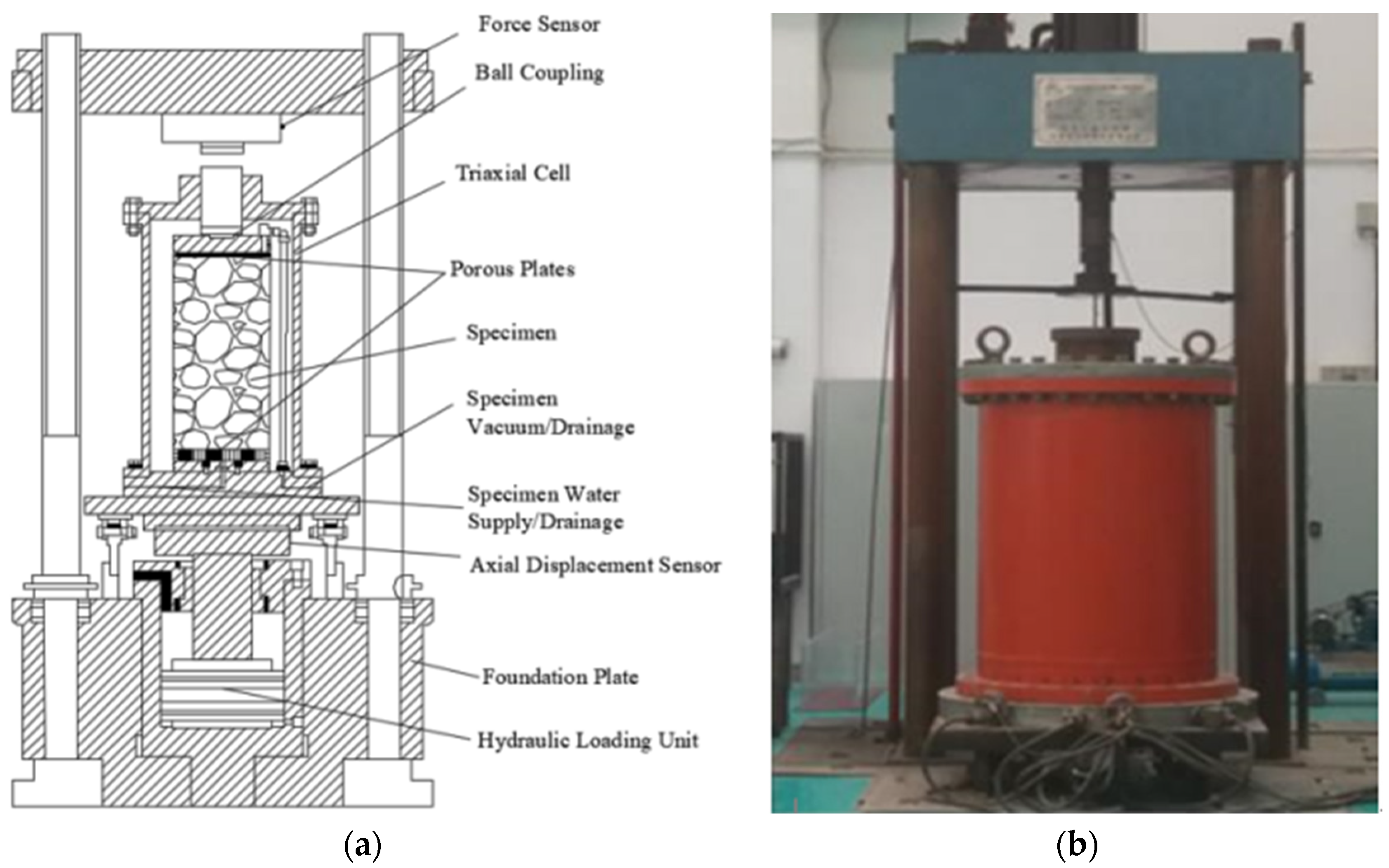

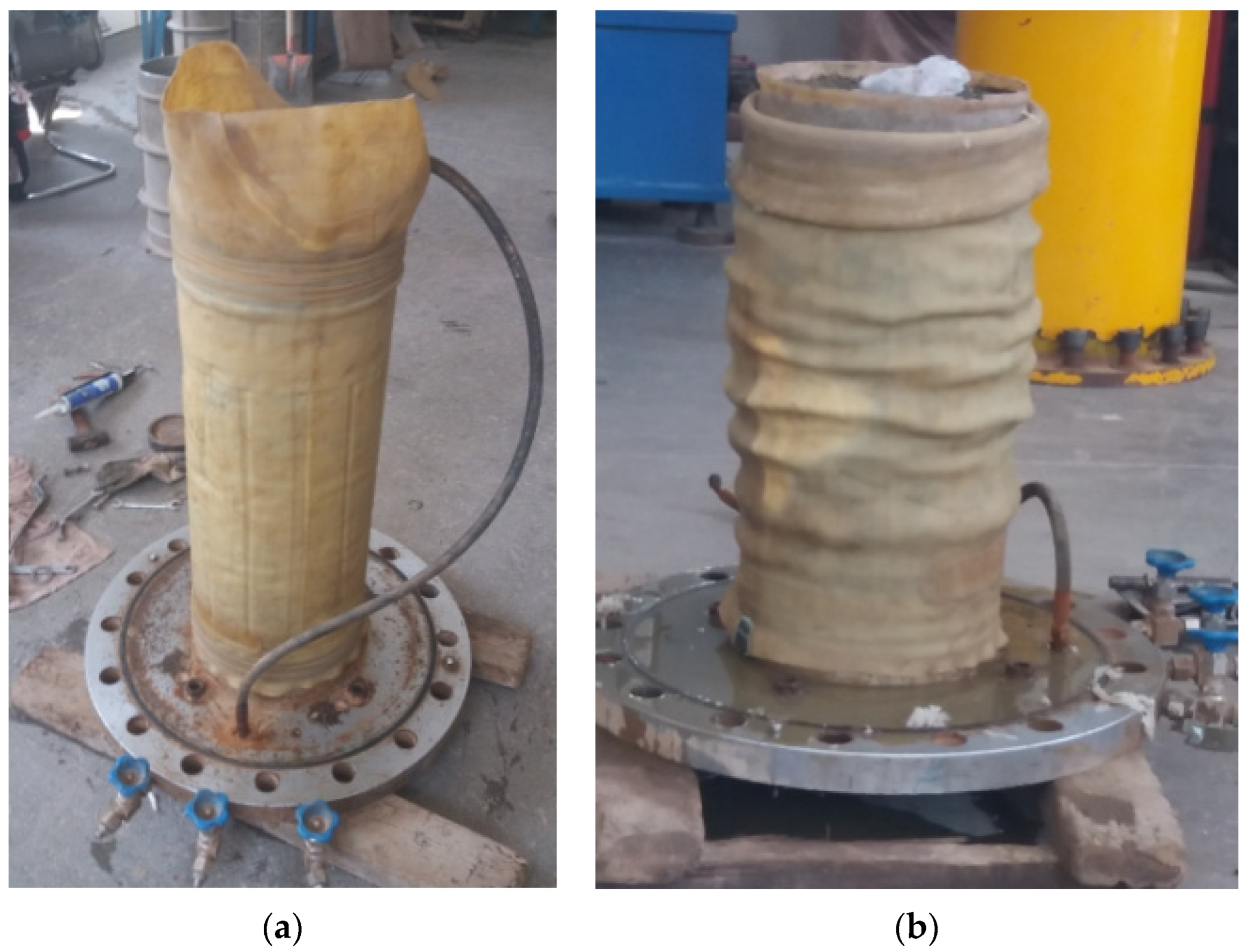

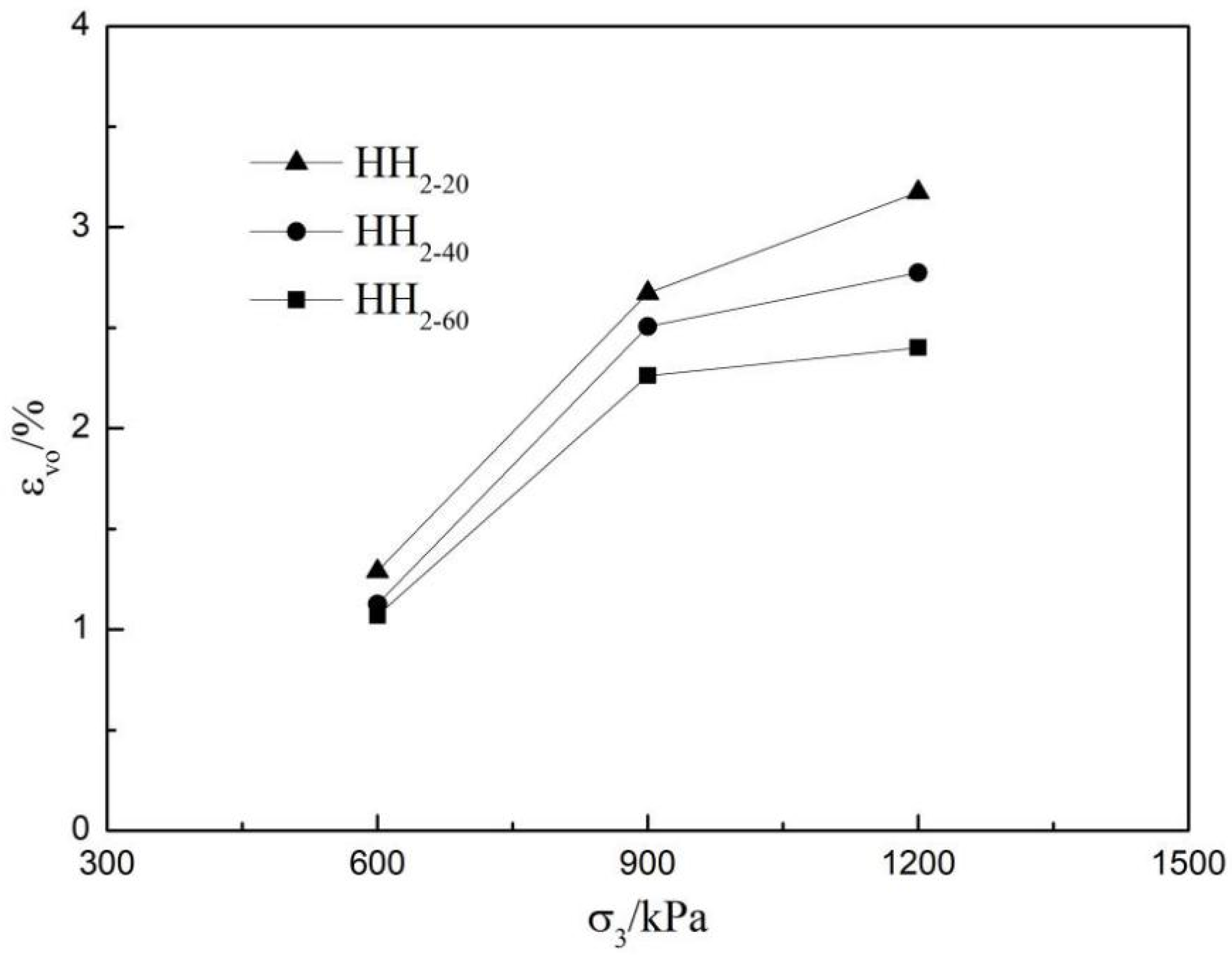
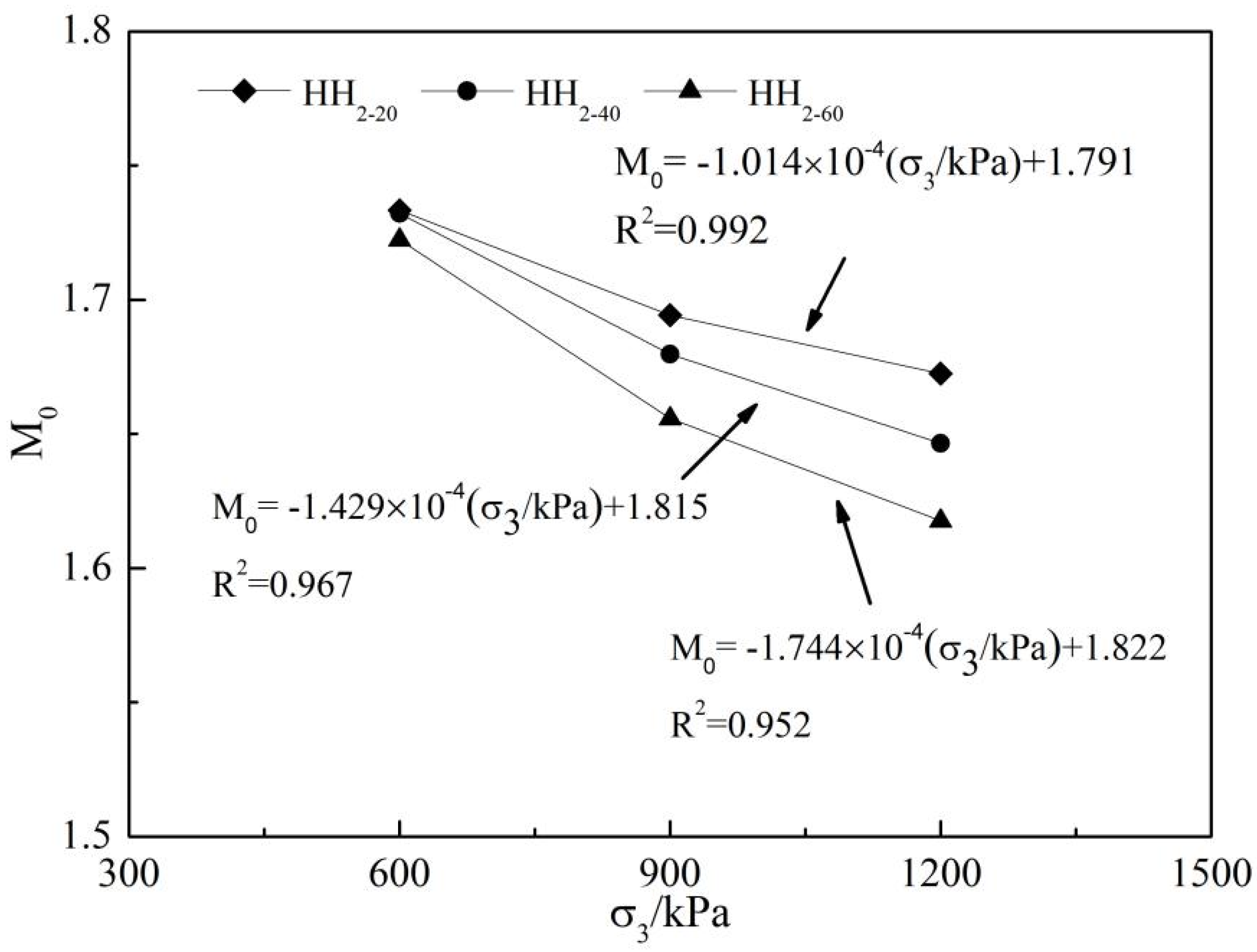
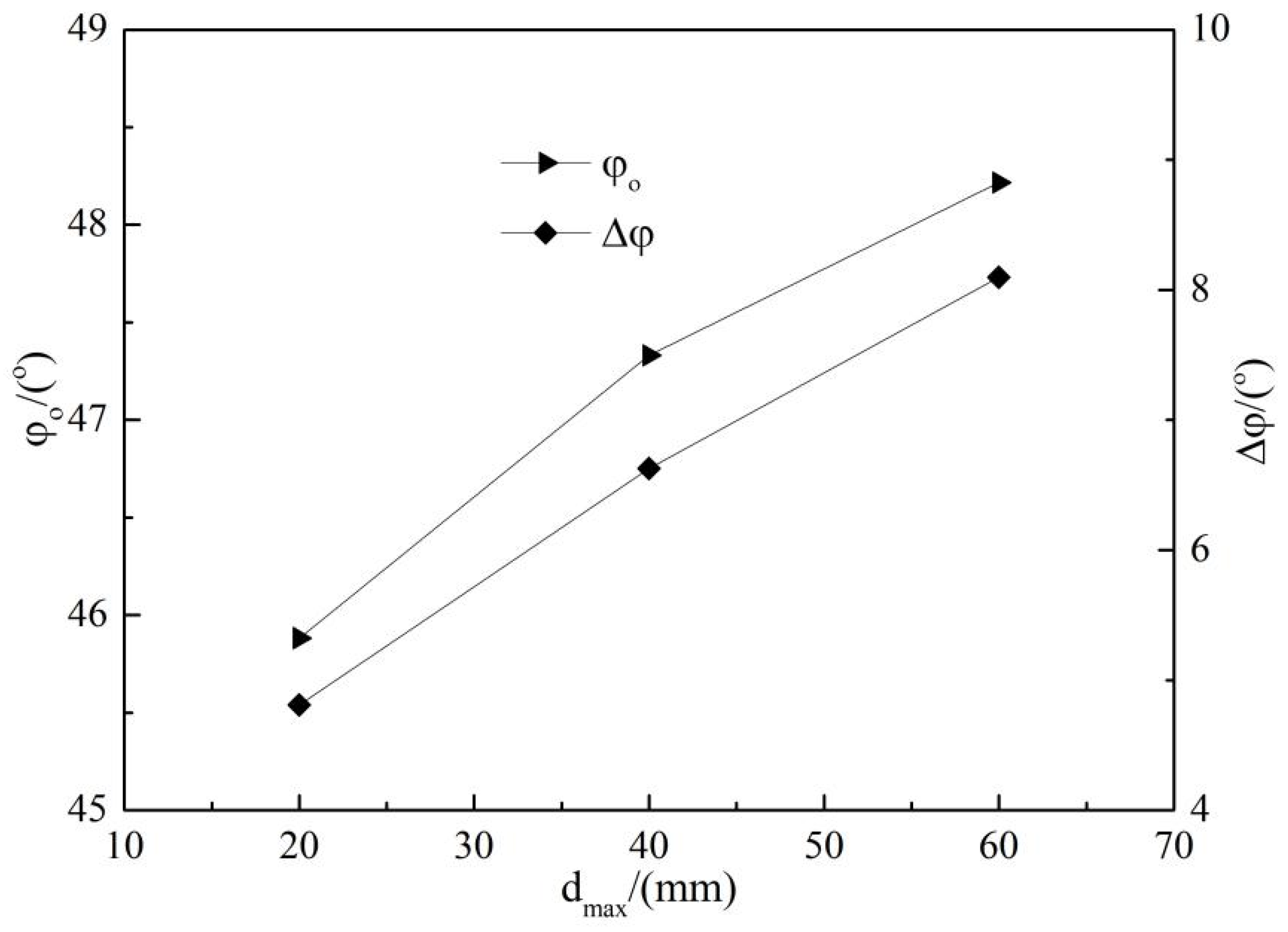
| Hybrid Method | Effective Particle Size d10 | Intermediate Particle Size d30 | Controlled Particle Size d60 | Nonuniformity Coefficient Cu | Curvature Coefficient Cc |
|---|---|---|---|---|---|
| HH2-60 | 2.89 | 9.86 | 24.55 | 8.49 | 1.37 |
| HH2-40 | 2.89 | 8.41 | 18.68 | 6.46 | 1.31 |
| HH2-20 | 2.89 | 6.69 | 11.47 | 3.97 | 1.35 |
| Hybrid Method | Sample Diameter/mm | |||
|---|---|---|---|---|
| HH2-60 | 300 | 60 | 2.181 | 600, 900, 1200 |
| HH2-40 | 300 | 40 | 2.155 | 600, 900, 1200 |
| HH2-20 | 300 | 20 | 2.114 | 600, 900, 1200 |
| Hybrid Method | ||||
|---|---|---|---|---|
| HH2-20 | 600 | 2463.2 | 125.37 | 38.33 |
| 900 | 3456.3 | |||
| 1200 | 4535.8 | |||
| HH2-40 | 600 | 2459.4 | 148.01 | 37.69 |
| 900 | 3435.1 | |||
| 1200 | 4379.2 | |||
| HH2-60 | 600 | 2426.3 | 166.87 | 36.74 |
| 900 | 3325.5 | |||
| 1200 | 4212.7 |
Publisher’s Note: MDPI stays neutral with regard to jurisdictional claims in published maps and institutional affiliations. |
© 2022 by the authors. Licensee MDPI, Basel, Switzerland. This article is an open access article distributed under the terms and conditions of the Creative Commons Attribution (CC BY) license (https://creativecommons.org/licenses/by/4.0/).
Share and Cite
Han, H.; Li, J.; Shi, J.; Yang, C. Influence of Scale Effect on Strength and Deformation Characteristics of Rockfill Materials. Materials 2022, 15, 5467. https://doi.org/10.3390/ma15155467
Han H, Li J, Shi J, Yang C. Influence of Scale Effect on Strength and Deformation Characteristics of Rockfill Materials. Materials. 2022; 15(15):5467. https://doi.org/10.3390/ma15155467
Chicago/Turabian StyleHan, Hongxing, Jing Li, Jicun Shi, and Cuina Yang. 2022. "Influence of Scale Effect on Strength and Deformation Characteristics of Rockfill Materials" Materials 15, no. 15: 5467. https://doi.org/10.3390/ma15155467






